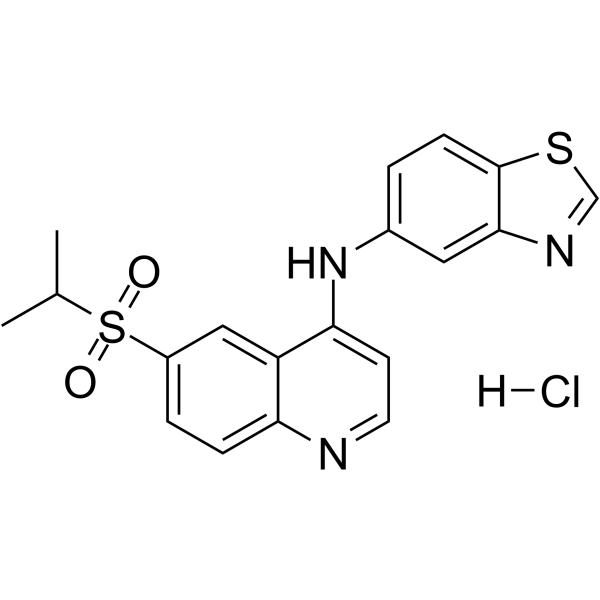2703752-81-0
| Name | GSK-872 hydrochloride |
|---|
| Description | GSK-872 hydrochloride is a RIPK3 inhibitor, which binds RIP3 kinase domain with an IC50 of 1.8 nM, and inhibits kinase activity with an IC50 of 1.3 nM. GSK-872 hydrochloride decreases the RIPK3-mediated necroptosis and subsequent cytoplasmic translocation and expression of HMGB1, as well as ameliorates brain edema and neurological deficits in early brain injury[1][2][3]. |
|---|---|
| Related Catalog | |
| Target |
IC50: 1.3 nM (RIPK3)[1] |
| In Vitro | GSK-872 (GSK'872; 0.01-3 μM; 24 hours) blocks TNF-induced necroptosis in human HT-29 cells in a concentration-dependent manner[1]. Cell Viability Assay[1] Cell Line: HT-29 cells Concentration: 0.01, 0.03 , 0.1, 0.3, 1, and 3 μM Incubation Time: 24 hours Result: Blocked TNF-induced necroptosis in a concentration-dependent manner. |
| In Vivo | GSK-872 hydrochloride (25 mM; intracerebroventricular injection) can attenuate brain edema and improve neurological function following subarachnoid hemorrhage (SAH) and reduce the number of necrotic cells. GSK-872 hydrochloride can also decrease the protein levels of RIPK3 and MLKL, and cytoplasmic translocation and expression of HMGB1, an important pro-inflammatory protein[3]. Animal Model: Eight weeks old Sprague-Dawley male rats with 300-320 g body weight (rat SAH model)[3] Dosage: 25 mM/6 μL Administration: Syringe pump (intracerebroventricular) at 30 min after SAH Result: Attenuated brain edema, improved neurological function and decreased the number of necrotic cells in the ipsilateral cortex. Decreased the expression of RIPK3, MLKL and cytoplasmic HMGB1 at 72 h after SAH in the ipsilateral cortex. |
| References |
| Molecular Formula | C19H18ClN3O2S2 |
|---|---|
| Molecular Weight | 419.95 |
